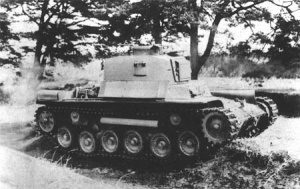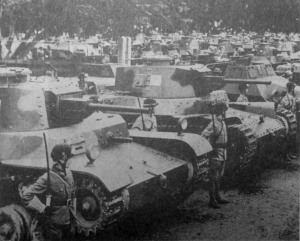Difference between revisions of "Chi-He (Family)"
Colok76286 (talk | contribs) (→Media: Added Shooting Range episode) |
(Somewhat Filled In History Bit) |
||
| Line 1: | Line 1: | ||
{{DISPLAYTITLE:Type 1 Chi-He (Family)}} | {{DISPLAYTITLE:Type 1 Chi-He (Family)}} | ||
== Description == | == Description == | ||
| − | The '''Type 1 ''Chi-He''''' ({{Annotation|一式中戦車 | + | The '''Type 1 ''Chi-He''''' ({{Annotation|一式中戦車 「チへ」|Ichi-shiki chū-sensha [Chi-He]}}) was an improved version of the [[Chi-Ha (Family)|Type 97 Chi-Ha medium tanks]] of the Imperial Japanese Army in World War II. It uses the same anti-tank gun as the [[Chi-Ha Kai]] and boasted an upgraded engine and thicker armour. It was the first Japanese tank to have a communication radio as standard equipment. |
== Vehicles == | == Vehicles == | ||
| Line 8: | Line 8: | ||
* [[Chi-He (5th Regiment)]] - 1st Tank Division, 2nd Armored Brigade, 5th Armored Regiment | * [[Chi-He (5th Regiment)]] - 1st Tank Division, 2nd Armored Brigade, 5th Armored Regiment | ||
| − | |||
== History == | == History == | ||
=== Design === | === Design === | ||
| − | + | {{main|Chi-Ha_(Family)#Type_97_Chi-Ha_Kai|l1=Development of the Chi-Ha Kai}} | |
| + | [[File:ShinHoTo Turret Testing.jpg|right|thumb|Type 1 Chi-He Prototype With Unarmed Turret]] | ||
| + | While the development of the new ''Chi-Ha Kai'' redesign was underway, the development of its new 47mm high-velocity gun and the new turret design would prompt a new tank on the side of development. | ||
| − | The | + | The new tank would go under the name of ''Chi-He'', and the turret design would directly be used on the ''Chi-He''. By 1941 both the tank and 47mm would be adopted within the army and were given the designation of Type 1 (47 mm) and Type 1 ''Chi-He''. |
| − | + | While the ''Chi-He'' looks very similar to the Chi-Ha, it has been simplified in design while being an upgrade at large with the changes being: | |
| + | * The ''Chi-Ha'' would see many rivets on the front of the tank, but on the ''Chi-He'' would be welded or flat bolted. | ||
| + | * As part of the simplification, the tank would see way less curved armour parts, and the whole body would be straightened out, unlike the ''Chi-Ha'''s design and would see an increase of thickness | ||
| + | ** The newly designed ''Chi-Ha Kai'' turret would be used with additional armour to the front face of the turret. | ||
| + | * The Mitsubishi SA12200VD was replaced by a Type 100 Mitsubishi engine which created 70 hp more and effortlessly compensates for the additional weight in armour. | ||
| + | ** The hull became slightly longer to mount the new engine | ||
| + | * The firing system was exchanged for an electrical one and got rid of the shoulder support mechanism | ||
| + | * It would be the first Japanese tank to have radio as standard equipment in every tank. | ||
| − | + | On testing of the ''Chi-Ha'' vs ''Chi-He'', a 15cm heavy howitzer would be used on both tanks where the ''Chi-Ha'' would pretty much fall apart, unlike the ''Chi-He'' that would allegedly still withstand the blast. Although it was an improvement over the ''Chi-Ha'' in most regards, it would come a little too late as it was already dated for a 1941 tank, which would be produced even later than that which didn't allow it to see frontline combat and would be held back for homeland defence. | |
| − | === | + | ===Combat History=== |
| − | [[File: | + | [[File:Type 1 Chi-He & Type 97 Chi-Ha Kai.jpg|left|thumb|Type 1 Chi-He, Type 97 Chi-Ha Kai And Type 1 Ho-Ha (Halftrack) Of The 1st Tank Division]] |
| − | + | A total of 170 ''Chi-He'''s were produced, including prototypes (with an unconfirmed total of 587). | |
| − | + | Americans first reported the new ''Chi-He'' during the Battle of Luzon, Philipines. But as they successfully engaged with the tanks and came for a closer inspection, it was simply the ''Chi-Ha Kai''. | |
| − | |||
| − | |||
| − | |||
| + | All of the '''Type 1 ''Chi-He's''''' were allocated to the Japanese home islands to defend against the projected Allied Invasion and never saw combat. Despite the ''Chi-He'''s superiority in terms of armour and firepower over the earlier [[Chi-Ha|Type 97 ''Chi-Ha'']], it still underperformed against the American [[M4 Sherman (Family)|M4 ''Sherman'']], leading to a new design known as the [[Chi-Nu|Type 3 ''Chi-Nu'']]. | ||
| + | {{Break}} | ||
== See Also == | == See Also == | ||
=== Medium Tanks === | === Medium Tanks === | ||
| Line 34: | Line 41: | ||
=== Gun Tank === | === Gun Tank === | ||
| − | *[[Ho-I|Type 2 Ho-I]] | + | *[[Ho-I|Type 2 Ho-I]] |
== Media == | == Media == | ||
Revision as of 08:49, 6 May 2021
Contents
Description
The Type 1 Chi-He (一式中戦車 「チへ」) was an improved version of the Type 97 Chi-Ha medium tanks of the Imperial Japanese Army in World War II. It uses the same anti-tank gun as the Chi-Ha Kai and boasted an upgraded engine and thicker armour. It was the first Japanese tank to have a communication radio as standard equipment.
Vehicles
Rank II
- Chi-He
- Chi-He (5th Regiment) - 1st Tank Division, 2nd Armored Brigade, 5th Armored Regiment
History
Design
While the development of the new Chi-Ha Kai redesign was underway, the development of its new 47mm high-velocity gun and the new turret design would prompt a new tank on the side of development.
The new tank would go under the name of Chi-He, and the turret design would directly be used on the Chi-He. By 1941 both the tank and 47mm would be adopted within the army and were given the designation of Type 1 (47 mm) and Type 1 Chi-He.
While the Chi-He looks very similar to the Chi-Ha, it has been simplified in design while being an upgrade at large with the changes being:
- The Chi-Ha would see many rivets on the front of the tank, but on the Chi-He would be welded or flat bolted.
- As part of the simplification, the tank would see way less curved armour parts, and the whole body would be straightened out, unlike the Chi-Ha's design and would see an increase of thickness
- The newly designed Chi-Ha Kai turret would be used with additional armour to the front face of the turret.
- The Mitsubishi SA12200VD was replaced by a Type 100 Mitsubishi engine which created 70 hp more and effortlessly compensates for the additional weight in armour.
- The hull became slightly longer to mount the new engine
- The firing system was exchanged for an electrical one and got rid of the shoulder support mechanism
- It would be the first Japanese tank to have radio as standard equipment in every tank.
On testing of the Chi-Ha vs Chi-He, a 15cm heavy howitzer would be used on both tanks where the Chi-Ha would pretty much fall apart, unlike the Chi-He that would allegedly still withstand the blast. Although it was an improvement over the Chi-Ha in most regards, it would come a little too late as it was already dated for a 1941 tank, which would be produced even later than that which didn't allow it to see frontline combat and would be held back for homeland defence.
Combat History
A total of 170 Chi-He's were produced, including prototypes (with an unconfirmed total of 587).
Americans first reported the new Chi-He during the Battle of Luzon, Philipines. But as they successfully engaged with the tanks and came for a closer inspection, it was simply the Chi-Ha Kai.
All of the Type 1 Chi-He's were allocated to the Japanese home islands to defend against the projected Allied Invasion and never saw combat. Despite the Chi-He's superiority in terms of armour and firepower over the earlier Type 97 Chi-Ha, it still underperformed against the American M4 Sherman, leading to a new design known as the Type 3 Chi-Nu.
See Also
Medium Tanks
- Type 97 Chi-Ha (Predecessor)
- Type 1 Chi-He
- Type 3 Chi-Nu (Successor)
Gun Tank
Media
- Videos
External links
| Japan medium tanks | |
|---|---|
| Type 97 | Chi-Ha · Chi-Ha Kai · Chi-Ha Kai TD · Chi-Ha Short Gun |
| Type 1 | Chi-He · Chi-He (5th Regiment) · Ho-I |
| Type 3 | Chi-Nu · Chi-Nu II |
| Type 4 | Chi-To · Chi-To Late |
| Type 5 | Chi-Ri II |
| Type 61 MBT | ST-A1* · ST-A2* · ST-A3* · Type 61 |
| Type 74 MBT | ST-B2* · Type 74 (C) · Type 74 (E) · Type 74 (F) · Type 74 (G) |
| Type 90 MBT | Type 90 · Type 90 (B) · Type 90 (B) "Fuji" |
| Type 10 MBT | TKX (P)* · TKX* · Type 10 |
| Other | Ka-Chi |
| USA | ▅M4A3 (76) W · ▅M47 |
| *Prototype | |





